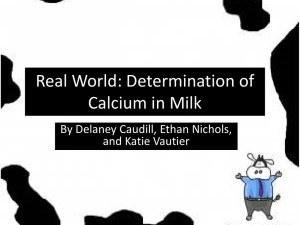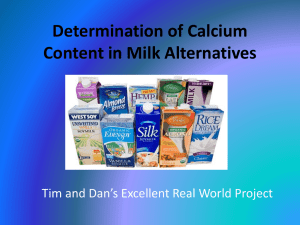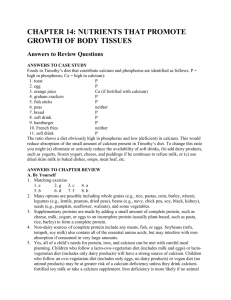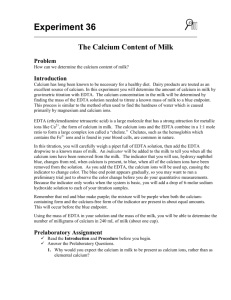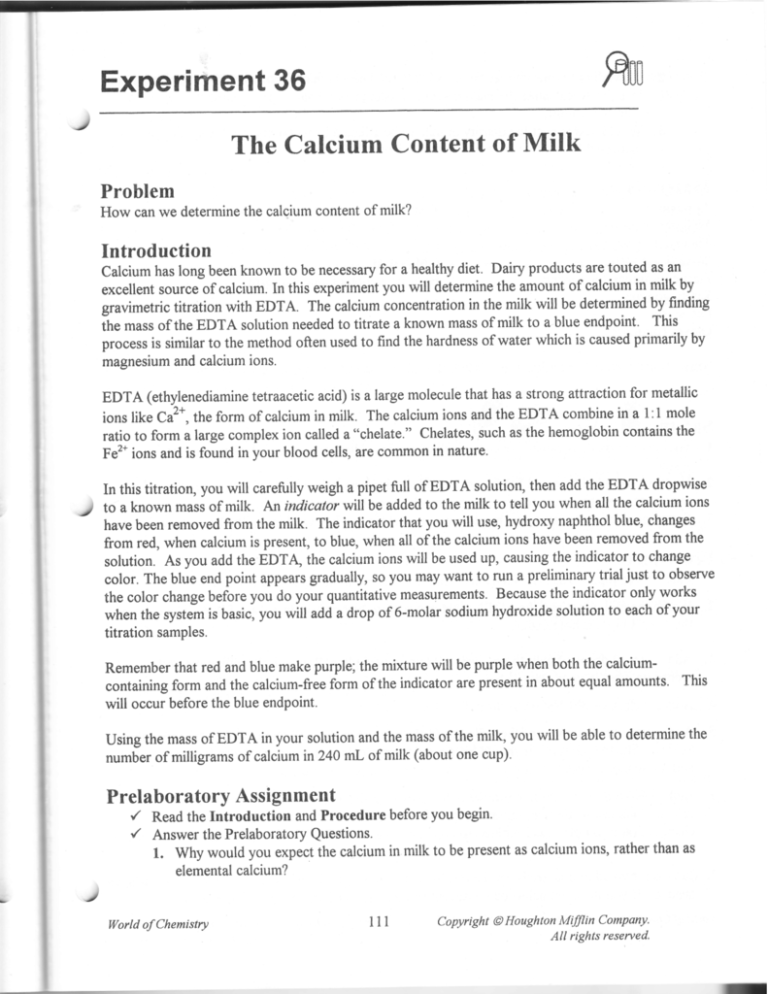
Experi ment 36
J
finn
The Calcium Content of Mitk
Problem
How can we determine the calcium content of milk?
Introduction
Calcium has long been known to be necessary for a healthy diet. Dairy products are touted as an
excellent rour.. of ralcium. In this experiment you will determine the amount of calcium in milk by
gravimetric titration with EDTA. The calcium concentration in the milk will be determined by finding
ih" *urr of the EDTA solution needed to titrate a known mass of milk to a blue endpoint' This
process is similar to the method often used to {ind the hardness of water which is caused primarily by
magnesium and calcium ions.
EDTA (ethylenediamine tetraacetic acid) is alarge molecule that has a strong attraction for metallic
ions like C**,theform of calcium in milk. The calcium ions and the EDTA combine in a l:l mole
ratio to form a large complex ion called a "chelate." Chelates, such as the hemoglobin contains the
Fe2* ions and is found in your blood cells, are common in nature'
J
In this titration, you will carefully weigh a pipet full ofEDTA solution, then add the EDTA dropwise
to a known mass of milk. An indicator will be added to the milk to tell you when all the calcium ions
have been removed from the milk. The indicator that you will use, hydroxy naphthol blue, changes
from red, when calcium is present, to blue, when all of the calcium ions have been removed from the
solution. As you add the EDTA the calcium ions will be used up, causing the indicator to change
color. The blue end point appears gradually, so you may want to run a preliminary trial just to observe
the color change before you do your quantitative measurements. Because the indicator only works
when the system is basic, yo, *ill add adrop of 6-molar sodium hydroxide solution to each of your
titration samples.
Remember that red and blue make purple; the mixture will be purple when both the calciumcontaining form and the calcium-free form of the indicator are present in about equal amounts. This
will occur before the blue endpoint.
the
Using the mass of EDTA in your solution and the mass of the milk, you will be able to determine
number of milligrams of calcium in240 mL of milk (about one cup).
Prelaboratory Assignment
{
,/
Read the Introduction and Procedure before you begin.
Answer the Prelaboratory Questions.
1. Why would you expect the calcium in milk to be present as calcium ions, rather than as
elemental calcium?
World of Chemistry
rll
Copyright
@
Mffiin Compnny.
All rights reserved"
Houghton
1
L,
', q--2-
^1r-v!rs.-.5
-".:
Use thl s to ; a"; ;
3,
mi{ltii
1Crfl
\'"'
.
:: :*.;i.lm in whole rnilk.
':;
Assume the densitv
of
Would
Would You expect ir.e ;c:'s::'" ;: ;r,k rc be afrected by its fat content? Explain.
increased fat content rai se cr icr', er the density? Explain.
Materials
Apparatus
Milligram balance
Thin-stem pipets (3)
Z$-well test Plate
Plastic toothPick for stirring
Safety goggles
Lab apron
Gloves (optional)
Note:
*
l.*
'\\\\ t'
A\
\t
Iepc
Ctear
1. Th
thi
Reagents
\Iilk; whole, Toh, skim
EDTA solution, 1.00%
6 I,{ NaOH
F{y'droxT naphthol blue indicator
2, pr
TI
tc
sl
3,\
An
Con
24-well plate'
Small beakers or flasks (e.g., 10-20 mL) may be substituted for the
in
'',$__r___=='--+
Saiety- il {J--
-v
l'.
large amounts of
Sodium hydroxide is caustic, even in small quantities. Clean up spills with
water.
contact with your skin' You
2. Hydroxy naphthol blue and EDTA are considered irritants; avoid
may want to wear gloves to protect your hands if you have sensitive skin'
in the laboratory'
3. S.f.tV goggles und u lab apron must be worn at all times when working
1"
AJ
bt_
Procedure
1. Label three pipets: EDTA NaoH and Milh fill each with the appropriate solution.
Z. Weigh the milk pipet and the EDTA pipet and record their masses in a Data Table' The mass of
the NaOH pipet is not needed.
3"
milk pipet and
Add t5 to 20 drops of milk to one well of your 24 well plate. Reweigh the
record its mass in your Data Table.
4.
Add one drop of 6M NaOH to the milk in the well plate'
few crystals are
very smal amount of the indicator to the mixture in the well plate. Only a
color is too light,
needed. Sii, tt . mixture. It should have a red to rose color. If you think the
add a few more crystals, but if you use too much, results will be inconsistent.
plate. As yoy add the EDTA" the
6, Add EDTA solution a drop at a time to the mixture in the well
causing the color to
calcium ions will be tied ui, removing them from the milk solution and
pipet after the solution has
change, first to purple, then to blue. Record the mass of the EDTA
turned blue.
7, Carryout two additional trials. If the results do not show good agreement, run additional trials, as
Ifyou have not achieved consistent results after 5 trials, consult your teacher.
F
5n
Add
a
neejed.
World of ChemistrY
1,12
Copyright
@
Mffiin Company'
All rights reserYed.
Houghton
1
8.
J
(Optional) Determine the density of milk in grams per milliliter, then use this experimental value
in your calculations rather than assuming that 240 mL of milk has a mass of 240 g. You must
report data and show calculations
Cleaning up
l.
2.
3.
The 6M sodium hydroxide, NaOH, is a strong base, so should be handled with care. Aside from
that, there are no environmental concerns connected with this experiment.
Depending on the fat content of the milk used, it may take some effort to clean the well plate.
The higher the fat content of the milk, the more oily the mixture and the more effort you will need
to get the wells clean. Wash everything well with soap and water and return it to the location
specified by your teacher.
Wash your hands thoroughly before leaving the laboratory.
Analysis and Conclusions
Complete the Analysis and Conclusions section for this experiment either on your Report Sheet or
in your lab report as directed by your teacher
l.
The concentration ofthe EDTA solution has been adjusted so that exactly 1 gram ofEDTA
solution will tie up exactly 1.08 mg of calcium. Calculate the number of milligrams of calcium
present in each of your three titration samples. Show your work for the first iitration. If you
carried out more than three titrations, base all your calculations on the three that show the best
agreement.
Use your results from the first calculation to determine the number of milligrams of calcium in
I cup (-240 mL) of milk. Report both the individual values for the three samples and an ave.rrga
value. Assume that skim milk has the same density as water. Show your *ork for trial l.
3. Calculate the individual deviations from the average for each trial. Calculate the average
deviation for your three trials.
4. When an average deviation is known for a series of analyses, the results of the analysis are
generally given in the form: (average value) * (average deviation). Report the concentration of
calcium in milk with the average deviation.
5. Calculate the percent deviation for your experimental results. Show your work.
6. The USRDA for calcium is 1200 mg per day. What fraction of the daily requirement would one
cup of milk provide, based on your average value?
7. According to the carton label, one cup of milk provides 35% ofthe USRDA for calcium. What is
your percentage error, assuming the carton value is correct?
8. Women over the age of 50 and men over age of 65 need about 50% more calcium than younger
adults. Why is this?
9. A student purchased a calcium supplement tablet which contained calcium carbonate. The student
placed the tablet in water for several hours. Addition of NaOH and the indicator gave a blue
solution. What does this indicate? Does this test show that the supplement is not giving the
student any useful calcium? Explain your reasoning. (Ilint: Consider solubility rules.)
Jz.
J
World of Chemistry
113
Copyright
@
Mffiin Company.
All rights reserved.
f{oughton

